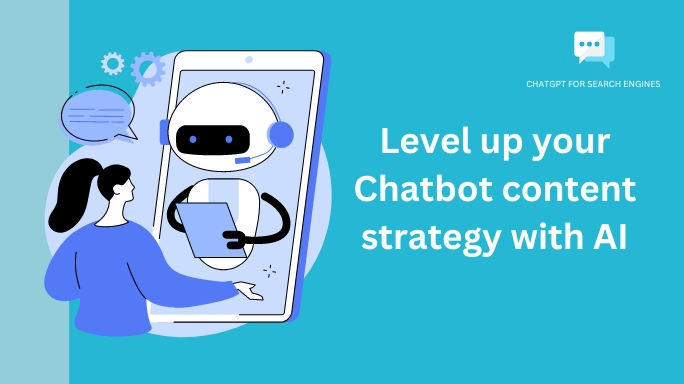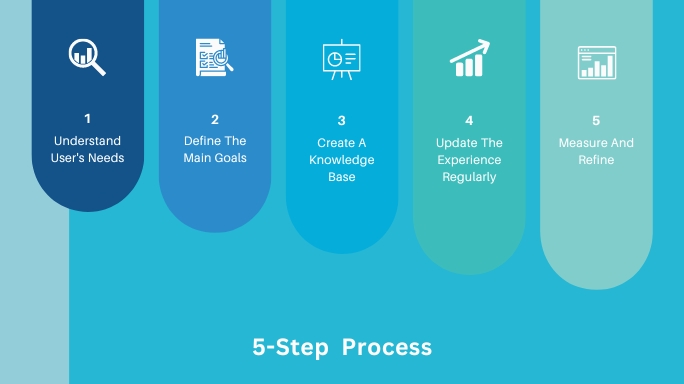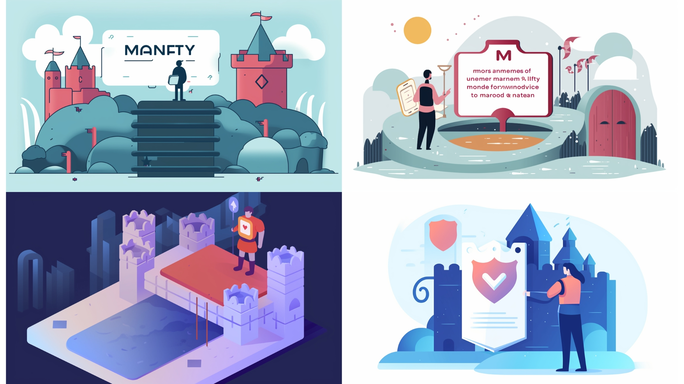How To Create The Best Chatbot Content Strategy With AI

Chat Bot Content Strategy With AI
Do you want to create a chatbot content strategy that rocks? Do you want to avoid wasting time and money on boring and ineffective content for your chatbot? I am sure we all do.
In this blog, we’ll show you how AI can make your chatbot content strategy easier and better than ever.
5 Steps To Create A Successful Chatbot Content Strategy
Before we delve into how AI can assist in content strategy, let's understand the basic steps involved in crafting a successful chatbot content strategy.

5 Steps Process
1. Understand User's Needs
This is probably the most important thing you have to do because it will shape who your chatbot is for. If you get this wrong, the rest of the steps won’t work either.
For example, let’s say you’re making a chatbot for a brand that sells clothes for toddlers. But if you decided that your users are young people, then you’re already off to a bad start.
2. Define The Main Goals
The next step is to know your goals.
Defining the goals of your strategy is an important part of any marketing strategy.
Knowing what you want to achieve and creating clear, measurable goals can help you create content that aligns with your objectives and track your results.
A great starting point is to find answers to these questions:
What do you want your chatbot to do? Is it to provide information, help with transactions, or offer customer support?
3. Create A Knowledge Base
A knowledge base is like the brain of the chatbot.
To create a successful chatbot you must equip it with a comprehensive knowledge base that the chatbot can refer to when generating responses.
This knowledge base should contain accurate and up-to-date information relevant to the chatbot's purpose.
The chatbot’s data should also be personalized based. This will help the chatbot to create customer-centric responses that are more engaging and personalized.
4. Update The Experience Regularly
The fourth step is to update and improve your chatbot content regularly.
As you have collected valuable user experience, it’s essential to use those to continuously improve your chatbot content.
By doing this, you will naturally gain a competitive advantage over your competitor by eliminating outdated content and updating the chatbot with effective, well-structured content.
5. Measure And Refine
This step goes hand in hand with step 2: define the main goals. Remember, you need to have clear and measurable goals to make a great chatbot.
You have to check how well your chatbot is doing. Did it meet the goals you set? How well did it do? How can you make it better? If it didn’t meet some goals, what can you do differently this time?
3 Ways AI Can Help You Create The Best Chatbot Content Strategy
AI can make your chatbot content strategy easier and better in many ways. Here are 3 key ways AI can help you:
1. Content Generation
One of the most obvious ways to use AI for your chatbot content strategy is to use it to generate content for you.
You can use tools like ChatGPT, Bing, Midjourney, and Stable Diffusion to generate high-quality content for your chatbot in minutes. All you have to do is provide some keywords or prompts, and the AI will do the rest. This can work for whatever content formats you are going to use.
For example, you can use ChatGPT to create a catchy greeting message for your Facebook messenger chatbot, like this:
👋 Hey there! Welcome to [Your Bot's Name]! 💬 I'm here to assist you, answer your questions, and provide helpful information. Whether you need recommendations, support, or just want to chat, I'm all ears! 🤖 Let's get started and make your day a little brighter! 😊✨
Or you can use Bing to create a comprehensive answer for a common user query, like this:
How do I reset my password?
To reset your password, please follow these steps:
- Go to the login page and click on “Forgot password”.
- Enter your email address and click on “Send reset link”.
- Check your inbox and click on the link in the email we sent you.
- Enter a new password and confirm it.
- Click on “Save changes” and log in with your new password.
Want engaging visual content? MidJourney can help you create stunning visual illustrations like this:

MidJourney Images
If you don’t want to invest in MidJourney or ChatGPT Plus, you can use other free ChatGPT alternatives to get similar results.
2. Content Improvement
But AI doesn’t stop at content creation. It can also help you improve and optimize your chatbot content to make it more effective and engaging.
Here are some ways you can use AI to enhance your chatbot content:
- You can use ChatGPT to test your chatbot content and see how it tackles problems differently from your chatbot. For example, you can ask ChatGPT the same questions that your users ask your chatbot, and compare the responses. You might discover some new ways to answer or handle certain situations that you can incorporate into your chatbot content.
- You can also use ChatGPT to chat with your chatbot and see how it reacts to different variations of user responses. For example, you can try different ways of saying yes or no, or asking for more information, or expressing dissatisfaction. You might find some gaps or flaws in your chatbot content that you need to fix or improve.
By using AI to improve your chatbot content, you can ensure that your chatbot delivers the best possible user experience and customer service.
3. Measurement and Refinement
The last way to use AI for your chatbot content strategy is to measure and refine your chatbot content based on data and feedback.
You can use AI tools that can track and analyze the performance and impact of your chatbot content, such as user retention, engagement, conversion, satisfaction, or sentiment.
For example, you can use Dashbot to get actionable insights and analytics on your chatbot interactions.
Dashbot can help you measure various metrics and KPIs for your chatbot, such as:
- How many users are interacting with your chatbot and how often
- How long are the chatbot sessions and how many messages are exchanged
- How many users are completing the chatbot goals or taking the desired actions
- How satisfied are the users with the chatbot service and content
- How do the users feel about the chatbot and what emotions do they express
Dashbot can also help you identify and optimize various aspects of your chatbot content, such as:
- What are the most common user queries and how well does your chatbot answer them
- What are the most engaging or effective chatbot messages and content types
- What are the most frequent or critical chatbot errors or failures and how to fix them
- What are the best practices or tips to improve your chatbot content and user experience
By using AI to measure and refine your chatbot content, you can continuously improve your chatbot performance and results.
Remember that while AI can be a helpful tool, they are only a machine. They can still make mistakes, and provide false information. Just like any tool, you still need to review and regulate the content generated by these models to maintain the quality of your chatbot.
Tips To Improve Your Chatbot Content Strategy
Now that you know how to create a successful chatbot content strategy with AI, let’s look at some tips to make it even better. Here are some things you can do to improve your chatbot content strategy:
Give Your Chatbot A Personality
Treat your chatbot like an employee, not a machine. It’s a representative of your brand and a friend to your users. So why not give it some personality? Giving your chatbot a personality can make it more fun and engaging for your users. It can also help you create a stronger connection with your target audience and differentiate yourself from your competitors.
But how do you give your chatbot a personality? Well, you need to think about some aspects of your chatbot’s character, such as:
- Name: Give your chatbot a catchy and memorable name that reflects its purpose and style.
- Voice: Choose a tone and style of voice that matches your brand and audience. Is your chatbot formal or casual? Friendly or professional? Humorous or serious?
- Avatar: Pick an image or icon that represents your chatbot’s appearance and identity. Is your chatbot human or animal? Realistic or cartoonish? Colorful or monochrome?
- Emotions: Decide how your chatbot expresses and responds to emotions. Does your chatbot use emojis or gifs? Does it show empathy or humor? Does it adapt to the user’s mood?
For example, take a look at Flo, the chatbot of Progressive Insurance.
Flo has a distinct personality that matches the company’s brand and spokesperson. She has a name, a voice, an avatar, and emotions that make her more relatable and likable to users.
Keep It Short And Concise
When it comes to chatbot content, less is more.
Ask yourself, when talking to a messenger chatbot, do you want a long answer to a simple question or a quick and easy one?
Definitely the latter right? Nobody wants to read a wall of text to find what they need. We don’t have time for that.
That’s why we need to keep your chatbot’s answer brief and clear. So, How do you do that? Here are some tips:
- Use simple and clear language: Avoid jargon, slang, or complex words that might confuse or frustrate users. Use plain and simple language that anyone can understand.
- Break up your content: Use bullet points, lists, or tables to present your content in a structured and organized way. This makes it easier for users to scan and digest your content.
- Provide options: Use buttons, menus, or carousels to offer users multiple choices or actions. This reduces the cognitive load and typing effort for users and guides them to their desired outcomes.
Create Engaging Content
Your chatbot content should not only be informative but also engaging.
You want to capture and retain your users’ attention and interest. You want to make them feel like they’re having a real conversation with a real person. You want to make them smile, laugh, or even cry.
How do you create engaging content? Here are some tips:
- Use storytelling techniques: Tell stories that resonate with your users and showcase your brand’s values and personality. Use anecdotes, examples, or testimonials to illustrate your points and make them more memorable.
- Use interactive elements: Add multimedia, gifs, or interactive prompts to make your chatbot content more dynamic and immersive. Use visuals to show rather than tell your users what you offer or how you can help them.
- Use humor and emotion: Add humor and emotion to your chatbot content to make it more human and appealing. Use jokes, puns, or compliments to lighten up the mood and make your users laugh. Use empathy, sympathy, or gratitude to show that you care and appreciate your users.
For example, take a look at Woebot, a chatbot that helps users cope with depression and anxiety. The chatbot uses storytelling techniques to share personal stories and insights. It uses interactive elements like quizzes, games, and exercises to keep users engaged and motivated. It also uses humor and emotion to make users feel comfortable and supported.
Final Thoughts
AI is a game-changer for chatbot content strategy. It can help you create amazing content, improve your strategy, and boost your user experience. You can use AI tools to make your chatbot content strategy easier and more effective.
With AI, you can create a chatbot that stands out from the crowd, delivers personalized experiences, and provides awesome customer service across different channels.
But remember, your chatbot content strategy is not a one-time thing. It’s a continuous process that needs constant evaluation, measurement, and refinement. You need to keep up with user feedback and market trends to make sure your chatbot content strategy is always relevant and engaging. Don’t be afraid to use AI as your friend and partner in creating the best chatbot content strategy possible. With AI, you can stay ahead of the curve and deliver exceptional user experiences.
